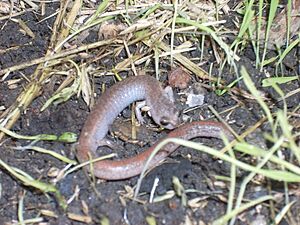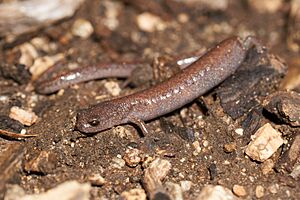Garden slender salamander facts for kids
Quick facts for kids Garden slender salamander |
|
|---|---|
 |
|
| Conservation status | |
| Scientific classification |
The Garden slender salamander (also known as Batrachoseps major) is a type of salamander. It belongs to a family called Plethodontidae. This salamander lives only in northern Baja California in Mexico and Southern California in the United States.
Contents
About the Garden Slender Salamander
The Garden slender salamander is a small creature. However, it is bigger than most other salamanders in its group, Batrachoseps. Adult salamanders are about 3.2 to 5.9 centimeters (1.3 to 2.3 inches) long. They have 17 to 21 grooves along their sides, called costal grooves. Like other Batrachoseps salamanders, this species has only four toes on its back feet.
What Does It Look Like?
The color of these salamanders can change a lot. But they are usually some shade of gray. A good way to tell them apart is by their belly color. The Garden slender salamander has a pale, light-colored underside. This helps tell it apart from a similar salamander, B. nigriventris. The B. nigriventris is also usually smaller and not as strong.
Types of Garden Slender Salamanders
There are two main types, or subspecies, of Batrachoseps major:
- Batrachoseps major major: This is the Garden slender salamander or Southern California slender salamander you just read about.
- Batrachoseps major aridus: This one is called the Desert slender salamander.

Where Do They Live?
The Garden slender salamander lives in a fairly small area. This area includes southern California and northwestern Baja California. You can find them from the San Fernando Valley in the north down to Ensenada. They have even been seen as far south as El Rosario. They also live on some islands, like Santa Catalina Island. They were probably brought to these islands by people. Even though their home range is small, there are usually many of them in these areas.
Favorite Places to Live
These salamanders mostly live in low-lying areas. In places like Los Angeles County, they stick to low valleys. They do not go far into the mountains, such as the San Gabriel Mountains. In those mountains, a different salamander, B. nigriventris, lives instead. Farther south, in places like San Diego County, B. major lives in many different elevations.
Their natural homes include coastal sage scrub, oak woodland, and conifer forests. Sometimes, they even live on the north-facing slopes of desert mountains. This salamander is also special because it can live well in cities. You can find them in yards and other places in the Los Angeles Basin. They just need some moisture to survive there. Sometimes, B. major and B. nigriventris can even be found living side-by-side under the same rocks or logs.
The Rare Desert Slender Salamander
The Desert slender salamander (B. m. aridus) is much rarer. It might even be gone forever, as no one has seen it since 1996. This subspecies lives in a tiny area. It can only be found in desert palm oases in two canyons near Palm Springs. These salamanders live near wet limestone spots. These spots have permanent water and are shaded by California fan palms. This helps them survive in a very dry desert.
How They Live
Daily Activities
Coastal California has very dry summers. Because of this, the Garden slender salamander is only active above ground in the wetter winter months. This is usually from October to June. These salamanders are active when the soil is between 5 and 21 degrees Celsius (41 to 70 degrees Fahrenheit). They need enough moisture to move around, which is why they are not active in the hot, dry summer.
What Do They Eat?
The Garden slender salamander eats worms, insects, and other small creatures without backbones. It uses its long tongue to catch its food. After catching prey, it can sometimes take more than 30 minutes for the salamander to swallow it!
Protecting the Salamander
The Garden slender salamander faces threats like habitat loss. This is a problem for many animals in southern California. However, this salamander is listed as a species of least concern by the IUCN Red List. This means it is not in immediate danger. B. major can live in places changed by humans, like suburban yards. It does this better than most other local amphibians. This allows it to live in cities where other native animals have disappeared.
One subspecies, the desert slender salamander (B. m. aridus), is a federally listed endangered species in the United States. It is possibly extinct, meaning it might be gone forever. No individuals have been found since 1996. However, no one has done a full search in many years. So, it is possible that some salamanders are still out there, just not found yet.


